Switch Cabinet Temperature Prediction Using a Fusion of CNN and LSTM Neural Networks
Abstract
1. Introduction
2. Methodology
2.1. Datase and Switchgear
2.2. CNNs
2.3. LSTMs
2.4. Model Training
2.5. Presentation of the Testing Problem
3. Results and Discussion
3.1. Correlation Analysis
3.2. CNN Model Regression Results
3.3. LSTM Model Regression Results
3.4. CNN-LSTM Regression Results
3.5. Presentation of the Testing Results and a Summary
4. Conclusions
Author Contributions
Funding
Data Availability Statement
Acknowledgments
Conflicts of Interest
References
- Li, Y.; Cheng, W. A novel temperature monitoring system based on FBG for switchgear. In Proceedings of the 2010 Asia-Pacific Power and Energy Engineering Conference, Chengdu, China, 28–31 March 2010; IEEE: Piscataway, NJ, USA, 2010; pp. 1–4. [Google Scholar]
- Shuxin, L.; Yundong, C.; Chunguang, H.; Xiaoming, L.; Jing, L. Development of on-line monitoring system of switchgear. In Proceedings of the 2011 1st International Conference on Electric Power Equipment-Switching Technology, Xi’an, China, 23–27 October 2011; IEEE: Piscataway, NJ, USA, 2011; pp. 295–298. [Google Scholar]
- Yan, Y.; Qi, D.; Gu, H. A real-time IR-fusion switchgear contact monitoring system (SCMS). IEEE Access 2017, 5, 12114–12124. [Google Scholar]
- Flurscheim, C. Switchgear. A review of progress. Proc. IEE-Part A Power Eng. 1956, 103, 239–262. [Google Scholar]
- Schaffer, J.S.; Hazel, T. Ensuring switchgear integrity in High-Power installations. IEEE Trans. Ind. Appl. 2014, 51, 2641–2650. [Google Scholar] [CrossRef]
- Smeets, R.; Van der Sluis, L.; Kapetanovic, M.; Peelo, D.F.; Janssen, A. Switching in Electrical Transmission and Distribution Systems; John Wiley & Sons: Hoboken, NJ, USA, 2015. [Google Scholar]
- Gupta, M.; Elahi, B. Prioritizing Failure-Contributing Causes in Switchgear Systems. In Proceedings of the 2025 Annual Reliability and Maintainability Symposium (RAMS), Destin, FL, USA, 27–30 January 2025; IEEE: Piscataway, NJ, USA, 2025; pp. 1–6. [Google Scholar]
- Razip, H.D.; Khairudin, F.R.; Harun, M.N. The impact of under sized cable on MV vacuum metal clad switchgear during fault. In Proceedings of the 2012 IEEE International Power Engineering and Optimization Conference, Melaka, Malaysia, 6–7 June 2012; IEEE: Piscataway, NJ, USA, 2012; pp. 312–316. [Google Scholar]
- Zeng, L.; Ge, X.; Zheng, W. DATA-DRIVEN transient temperature rise prediction model for medium-voltage switchgear. In Proceedings of the CIRED 2021-The 26th International Conference and Exhibition on Electricity Distribution, Online, 20–30 September 2021; IET: Hertfordshire, UK, 2021; pp. 162–166. [Google Scholar]
- Matin, M.; Dehghanian, A.; Zeinaddini, A.H.; Darijani, H. Interpretable machine learning modeling of temperature rise in a medium voltage switchgear using multiphysics CFD analysis. Case Stud. Therm. Eng. 2025, 65, 105585. [Google Scholar]
- Shen, G.; Zhang, L.; Zhu, J.; Xu, M.; Zhu, M.; Chong, P. Research on Temperature and Humidity Prediction Model of High Voltage Switchgear Based on SSA-BP Algorithm. In Proceedings of the 2022 4th International Conference on Smart Power & Internet Energy Systems (SPIES), Beijing, China, 9–12 December 2022; IEEE: Piscataway, NJ, USA, 2022; pp. 1059–1064. [Google Scholar]
- Alsumaidaee, Y.A.M.; Yaw, C.T.; Koh, S.P.; Tiong, S.K.; Chen, C.P.; Ali, K. Review of medium-voltage switchgear fault detection in a condition-based monitoring system by using deep learning. Energies 2022, 15, 6762. [Google Scholar]
- Hoffmann, M.W.; Wildermuth, S.; Gitzel, R.; Boyaci, A.; Gebhardt, J.; Kaul, H.; Amihai, I.; Forg, B.; Suriyah, M.; Leibfried, T.; et al. Integration of novel sensors and machine learning for predictive maintenance in medium voltage switchgear to enable the energy and mobility revolutions. Sensors 2020, 20, 2099. [Google Scholar] [CrossRef] [PubMed]
- Heo, J.; Zhang, Y.; Bae, J.; Lim, S.; Shin, W.G.; Kim, S.B. Explainable Machine Learning-based Meta-modeling for Predicting Fire Damage to Motor Control Cabinets in a Switchgear Room. Nucl. Eng. Technol. 2025, 58, 103862. [Google Scholar]
- Sun, L.; Li, Y.; Gong, F.; Liu, G.; Yang, Z. Application of CNN in condition monitoring of high-voltage switchgear. In Proceedings of the International Conference on Physics, Photonics, and Optical Engineering (ICPPOE 2024), Singapore, 8–10 November 2025; SPIE: Bellingham, WA, USA, 2025; pp. 383–389. [Google Scholar]
- Ishaq, A.; Junaid, M.; Hussain, G.A.; Khan, S.U.; Chen, Y.; Yu, D. Partial Discharge Defect Classification in MV Switchgear by Using CWT and Deep Learning Approach. IEEE Trans. Instrum. Meas. 2025, 74, 1–12. [Google Scholar] [CrossRef]
- Yan, J.; Wang, Y.; Wang, J.; Geng, Y.; Srinivasan, D. A novel transformer-LSTM-based multitask network for partial discharge condition assessment in gas-insulated switchgear. In Proceedings of the 2024 10th International Conference on Condition Monitoring and Diagnosis (CMD), Gangneung, Republic of Korea, 20–24 October 2024; IEEE: Piscataway, NJ, USA, 2024; pp. 98–101. [Google Scholar]
- Santillan, P.B.; Magwili, G.V. Time-series prediction of busbar temperature rise based on LSTM neural network. In Proceedings of the 2023 IEEE 5th Eurasia Conference on IOT, Communication and Engineering (ECICE), Yunlin, Taiwan, 27–29 October 2023; IEEE: Piscataway, NJ, USA, 2023; pp. 133–138. [Google Scholar]
- Moon, S.; Cho, H.; Koh, E.; Cho, Y.S.; Oh, H.L.; Kim, Y.; Kim, S.B. Remanufacturing decision-making for gas insulated switchgear with remaining useful life prediction. Sustainability 2022, 14, 12357. [Google Scholar] [CrossRef]
- Alsumaidaee, Y.A.M.; Yaw, C.T.; Koh, S.P.; Tiong, S.K.; Chen, C.P.; Yusaf, T.; Abdalla, A.N.; Ali, K.; Raj, A.A. Detection of corona faults in switchgear by using 1D-CNN, LSTM, and 1D-CNN-LSTM methods. Sensors 2023, 23, 3108. [Google Scholar]
- Alsumaidaee, Y.A.M.; Paw, J.K.S.; Yaw, C.T.; Tiong, S.K.; Chen, C.P.; Yusaf, T.; Benedict, F.; Kadirgama, K.; Hong, T.C.; Abdalla, A.N. Fault detection for medium voltage switchgear using a deep learning hybrid 1D-CNN-LSTM model. IEEE Access 2023, 11, 97574–97589. [Google Scholar]
- Alsumaidaee, Y.A.M.; Yahya, M.M.; Yaseen, A.H. Reliable Mechanical Fault Diagnosis in Medium Voltage Electrical Switchgear Using a 1D-Convolutional Neural Network. J. Eur. Syst. Autom. 2024, 57, 1461. [Google Scholar]
- Li, Z.; Qu, N.; Li, X.; Zuo, J.; Yin, Y. Partial discharge detection of insulated conductors based on CNN-LSTM of attention mechanisms. J. Power Electron. 2021, 21, 1030–1040. [Google Scholar] [CrossRef]
- Zhou, N.; Xu, Y.; Cho, S.; Wee, C.T. A systematic review for switchgear asset management in power grids: Condition monitoring, health assessment, and maintenance strategy. IEEE Trans. Power Deliv. 2023, 38, 3296–3311. [Google Scholar] [CrossRef]
- Purwono, P.; Ma’arif, A.; Rahmaniar, W.; Fathurrahman, H.I.K.; Frisky, A.Z.K.; Haq, Q.M.U. Understanding of convolutional neural network (cnn): A review. Int. J. Robot. Control Syst. 2022, 2, 739–748. [Google Scholar]
- Van Houdt, G.; Mosquera, C.; Nápoles, G. A review on the long short-term memory model. Artif. Intell. Rev. 2020, 53, 5929–5955. [Google Scholar] [CrossRef]
- Grossberg, S. Recurrent neural networks. Scholarpedia 2013, 8, 1888. [Google Scholar] [CrossRef]
- Yu, Y.; Si, X.; Hu, C.; Zhang, J. A review of recurrent neural networks: LSTM cells and network architectures. Neural Comput. 2019, 31, 1235–1270. [Google Scholar] [CrossRef] [PubMed]
- Zargar, S. Introduction to Sequence Learning Models: RNN, LSTM, GRU. Ph.D. Thesis, Department of Mechanical and Aerospace Engineering, North Carolina State University, Raleigh, NC, USA, 2021. Volume 37988518. [Google Scholar]
- Schober, P.; Boer, C.; Schwarte, L.A. Correlation Coefficients: Appropriate Use and Interpretation. Anesth. Analg. 2018, 126, 1763. [Google Scholar] [CrossRef] [PubMed]
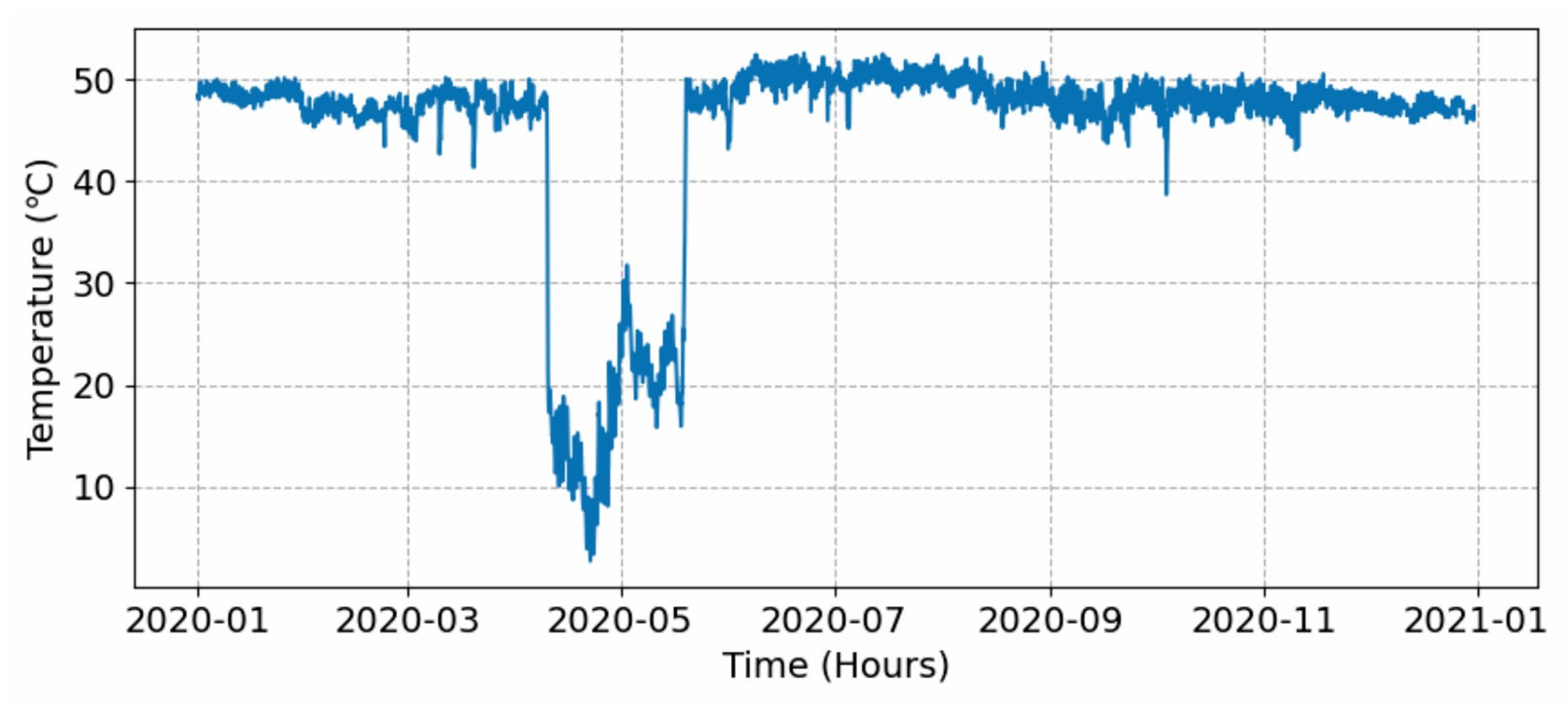
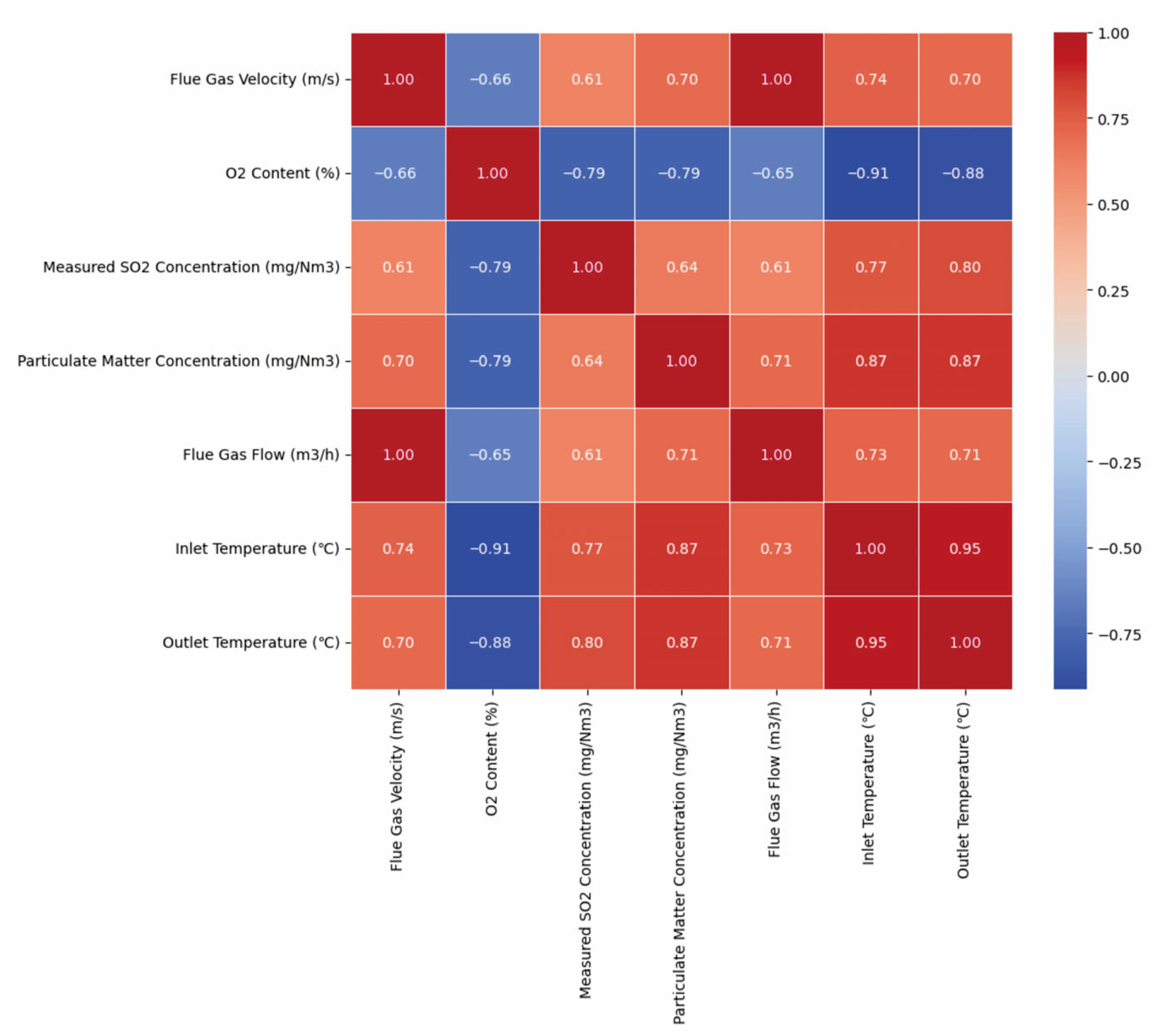
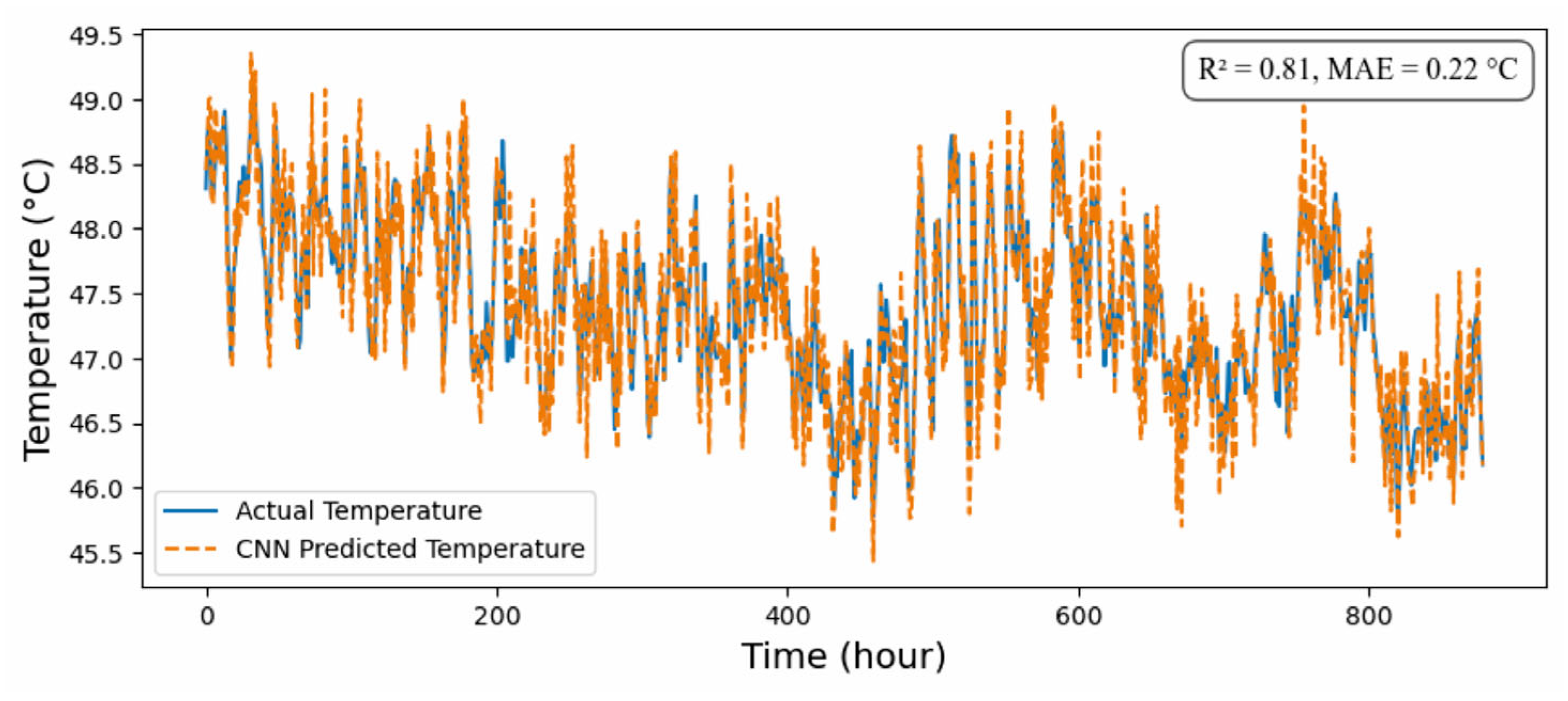
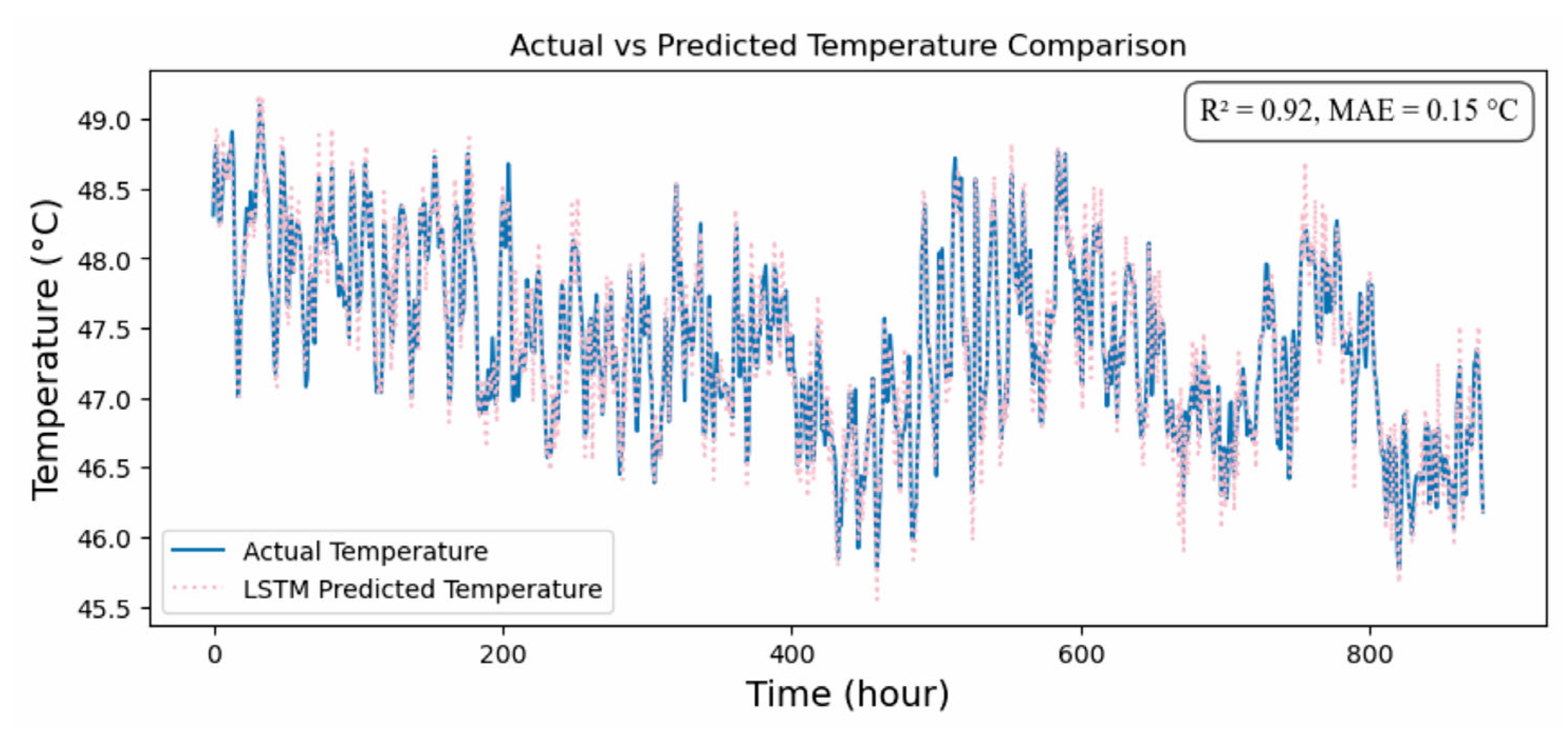
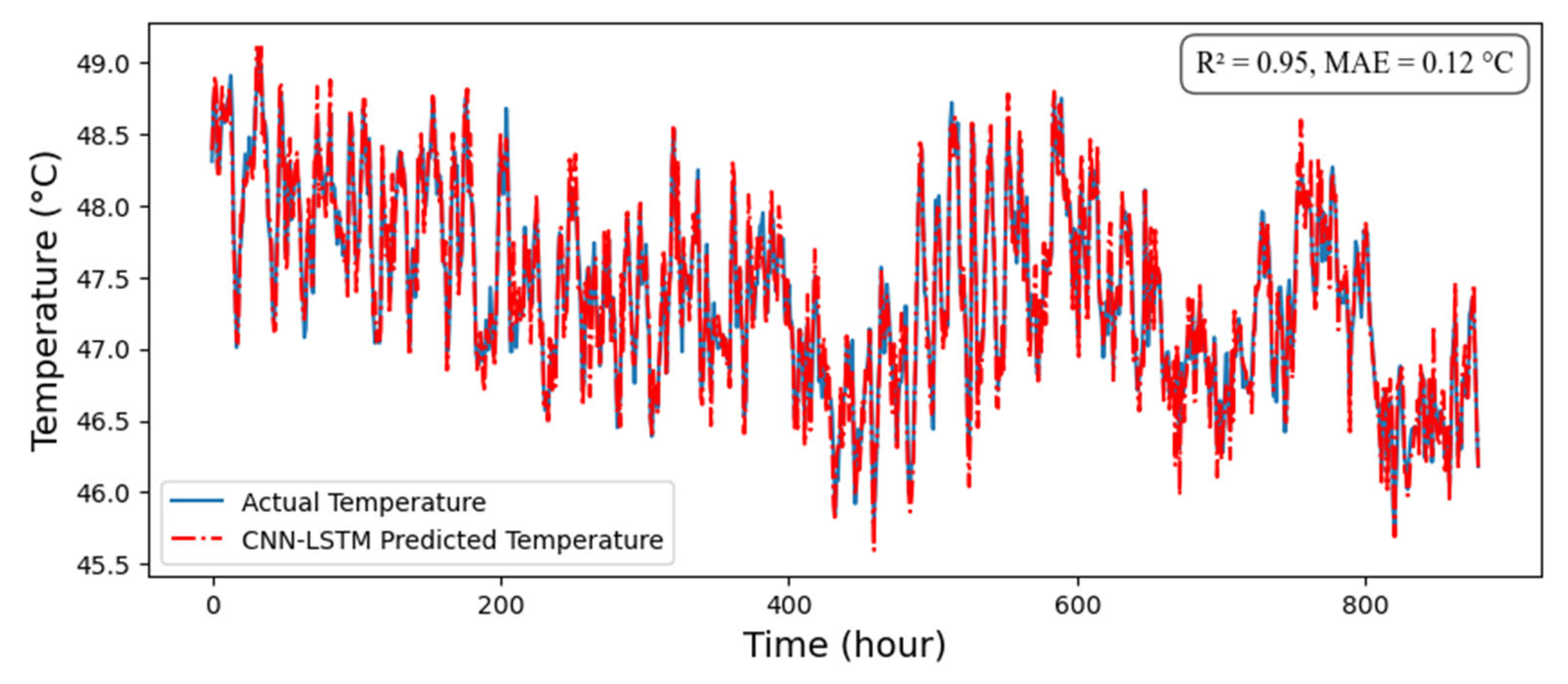
| Model | MAE | |
|---|---|---|
| CNN | 0.81 | 0.22 |
| LSTM | 0.92 | 0.15 |
| CNN-LSTM | 0.95 | 0.12 |
Disclaimer/Publisher’s Note: The statements, opinions and data contained in all publications are solely those of the individual author(s) and contributor(s) and not of MDPI and/or the editor(s). MDPI and/or the editor(s) disclaim responsibility for any injury to people or property resulting from any ideas, methods, instructions or products referred to in the content. |
© 2025 by the authors. Published by MDPI on behalf of the International Institute of Knowledge Innovation and Invention. Licensee MDPI, Basel, Switzerland. This article is an open access article distributed under the terms and conditions of the Creative Commons Attribution (CC BY) license (https://creativecommons.org/licenses/by/4.0/).
Share and Cite
Sun, X.; Chen, Y.; Wei, J.; Liu, Q.; Guo, H.; Cheng, R. Switch Cabinet Temperature Prediction Using a Fusion of CNN and LSTM Neural Networks. Appl. Syst. Innov. 2025, 8, 157. https://doi.org/10.3390/asi8050157
Sun X, Chen Y, Wei J, Liu Q, Guo H, Cheng R. Switch Cabinet Temperature Prediction Using a Fusion of CNN and LSTM Neural Networks. Applied System Innovation. 2025; 8(5):157. https://doi.org/10.3390/asi8050157
Chicago/Turabian StyleSun, Xu, Yun Chen, Jiang Wei, Qi Liu, Hui Guo, and Ruijian Cheng. 2025. "Switch Cabinet Temperature Prediction Using a Fusion of CNN and LSTM Neural Networks" Applied System Innovation 8, no. 5: 157. https://doi.org/10.3390/asi8050157
APA StyleSun, X., Chen, Y., Wei, J., Liu, Q., Guo, H., & Cheng, R. (2025). Switch Cabinet Temperature Prediction Using a Fusion of CNN and LSTM Neural Networks. Applied System Innovation, 8(5), 157. https://doi.org/10.3390/asi8050157






